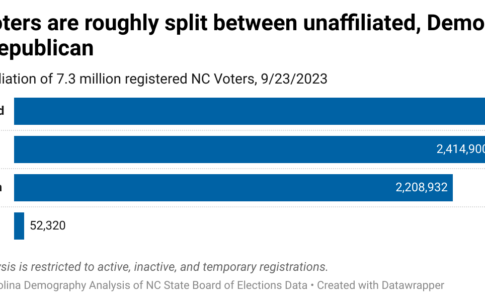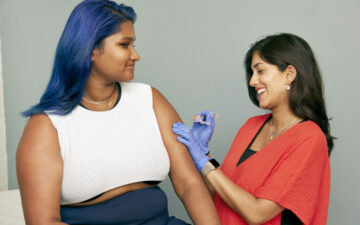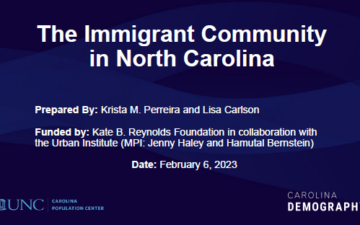Who are North Carolina’s 7.3 million registered voters? (2023)

This is the first in a four-part series on North Carolina’s voters. Today, we take a look at North Carolina’s 7.3 million registered voters. In the coming days, we will take a look at North Carolina’s registered Republicans, Democrats, and Unaffiliated Voters, respectively.
As of September 23rd, 2023, North Carolina had about 7.9 million voting-eligible adults and 7.3 million registered voters. Their partisan affiliation was roughly split between three groups: unaffiliated, Democrat, and Republican, with a slight lead to unaffiliated. Specifically:
Other party registrations included Libertarian (49,748 or 0.7%), Green Party (1,472 or 0.02%), and No Labels (1,100 or 0.01%).
Who are these voters? And how do demographic characteristics vary among the largest affiliation groups (Democratic, Republican, and unaffiliated)?
Statewide, just over one fifth of voters first registered to vote earlier than 2000. Nearly one fourth of all Democrats (24%) and Republicans (25%) registered to vote before 2000. However, just 13% of unaffiliated voters registered before the turn of the millennium.
Over 72% of unaffiliated voters first registered after 2010; at the same time, only 57% of both Democrat and Republican voters registered in 2010 or later. This reflects two factors: first, age group differences in partisan affiliation and second, the continuing rise of unaffiliated voters in recent years.
Young voters are more likely to register as unaffiliated than any other age group: 46% of 18-34 year-olds are registered unaffiliated versus 39% of 35-44 year-olds, 29% of 55-74 year-olds, and 25% of voters 75 and older.
Conversely, 18-34 year-olds are least likely to register as Republican (23%) and adults ages 55-74 (36%) and 75 and older (37%) are the most likely to register as Republican. Older voters—ages 75 and older—are the most likely to register as Democrats (38%), followed by voters 55-74 (35%).
Reflecting these age patterns in partisan affiliation, the youngest voters make up just over a fifth of all Republican voters (21%), a quarter of Democrat voters (25%) and the largest share of unaffiliated voters (35%). Meanwhile, both Republican and Democrat registered voters have a higher share of voters aged 55-74 and 75 and older than the electorate overall.
There are significant differences in party registration by race and ethnicity. Voters identifying as Black (75%) or as two or more races (43%) are most likely to be registered Democrat while white (20%) voters are least likely to be registered Democrat. In contrast, white voters (41%) are most likely to be registered Republican and black (3%) voters are least likely to be registered Republican. Asian voters (53%) and voters residing in the undesignated race category (53%) are most likely to be registered unaffiliated, followed by the other category (48%) and Hispanic (46%). Black voters (22%) are the least likely to be registered unaffiliated.
As a result of these differing registration patterns, North Carolina’s registered Republicans are overwhelmingly white. Eighty-eight percent of Republican voters are white compared to 64% of the electorate overall.
Democratic voters are the only party where white voters are a minority of registered voters: 40% of registered Democratic voters identify as white. Black voters comprise the largest share of registered Democrats (46%).
Unaffiliated voters are more diverse, with higher shares of Hispanic (4%) and Asian (2%) voters than the electorate overall.
Nearly two in every five (38%) of registered voters in North Carolina were born in the state. Another 20% did not report a place of birth. New York (5%), other countries (3%), and Virginia (3%) were the next most common places of birth.
North Carolina-born voters were more common among registered Democrats (42%) and Republicans (42%); unaffiliated voters were less likely to be born in North Carolina (33%) than the average registered voter.
Party preferences vary by place of birth with some regional patterns evident. DC, New York, and voters born in the Carolinas were most likely to register as Democrats: 49% of voters born in DC are registered as Democrats, the highest of any state of birth, followed by South Carolina (39%), New York (36%), and North Carolina (36%) born voters.
Southern-born and Midwestern-born voters were most likely to register as Republican: 42% of West Virginia-born voters are registered Republican, followed by South Dakota (39%), Kentucky (38%), Oklahoma (36%), Indiana (36%), and Tennessee (35%). Midwestern-born voters were the region least likely to register Democrat (25%).
Western-born and Northeastern-born voters are more likely to register unaffiliated. Utah-born voters lead the Western region with 49% of them registering as unaffiliated, followed by Idaho (45%), Nevada (45%), Colorado (44%), and Arizona (43%). In the Northeast, over half of Rhode Island-born voters are registered unaffiliated, followed by Massachusetts (50%), New Hampshire (49%), and Vermont (47%).
Less than one-fifth of voters originally from another country register to vote Republican, nearly half register unaffiliated (45%) and another 34% register Democrat.
Across North Carolina’s 100 counties, the partisan affiliation of voters varies widely, reflecting county differences in composition by age, race/ethnicity, and place of birth. As mentioned, unaffiliated voters are on the rise, so concentrated pockets of one party are becoming less frequent.
Fifty-eight percent of active voters in Mitchell County were registered Republican, the highest rate statewide. Mitchell also had the lowest rate of registered Democratic voters (9%). In Hertford County, meanwhile, 64% of voters are registered Democrats, the highest rate statewide; Hertford County also had the second lowest rate of registered Republican voters (11%). Durham County had the lowest rate of registered Republican voters (10%).
There are less clear regional patterns in unaffiliated registrations. The top 10 counties for unaffiliated voters include:
Note: Analysis presented is of the 9/23/2023 voter registration file from NC’s State Board of Elections. Analysis is limited to individuals who are active, inactive, or temporary registered voters. Voters with a reported birth age of 116 years or older were excluded from the age analysis. Thus, those born before 1909 were excluded. Likewise, voters with registration dates prior to 1930 were excluded from the registration date analysis.
Need help understanding population change and its impacts on your community or business? Carolina Demography offers demographic research tailored to your needs.
Contact us today for a free initial consultation.
Contact UsCategories: Carolina Demographics, Elections & Voting

The Center for Women’s Health Research (CWHR) at the University of North Carolina School of Medicine released the 12th edition of our North Carolina Women’s Health Report Card on May 9, 2022. This document is a progress report on the…

Dr. Krista Perreira is a health economist who studies disparities in health, education, and economic well-being. In collaboration with the Urban Institute, she recently co-led a study funded by the Kate B. Reynolds Foundation to study barriers to access to…

Our material helped the NC Local News Lab Fund better understand and then prioritize their funding to better serve existing and future grant recipients in North Carolina. The North Carolina Local News Lab Fund was established in 2017 to strengthen…
Your support is critical to our mission of measuring, understanding, and predicting population change and its impact. Donate to Carolina Demography today.